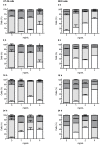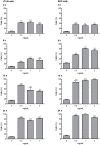Pro-Apoptotic Activity of Artichoke Leaf Extracts in Human HT-29 and RKO Colon Cancer Cells
- PMID: 33920761
- PMCID: PMC8071198
- DOI: 10.3390/ijerph18084166
Pro-Apoptotic Activity of Artichoke Leaf Extracts in Human HT-29 and RKO Colon Cancer Cells
Abstract
(1) Background: Cynara cardunculus L. subsp. scolymus (L.) Hegi, popularly known as artichoke, is an herbaceous plant belonging to the Asteraceae family. Artichoke leaf extracts (ALEs) have been widely used in traditional medicine because of their hepatoprotective, cholagogic, hypoglycaemic, hypolipemic and antibacterial properties. ALEs are also recognized for their antioxidative and anti-inflammatory activities. In this study, we evaluated the cytotoxic, genotoxic, and apoptotic activities, as well as effect on cell growth of ALEs on human colon cancer HT-29 and RKO cells. HT-29 and RKO cells exhibit a different p53 status: RKO cells express the wild-type protein, whereas HT-29 cells express a p53-R273H contact mutant. (2) Methods: Four different ALEs were obtained by sequential extraction of dried artichoke leaves; ALEs were characterized for their content in chlorogenic acid, cynaropicrin, and caffeoylquinic acids. HT-29 and RKO cells were used for in vitro testing (i.e., cytotoxicity and genotoxicity assessment, cell cycle analysis, apoptosis induction). (3) Results: Two out of the four tested ALEs showed marked effects on cell vitality toward HT-29 and RKO tumour cells. The effect was accompanied by a genotoxic activity exerted at a non-cytotoxic concentrations, by a significant perturbation of cell cycle (i.e., with increase of cells in the sub-G1 phase), and by the induction of apoptosis. (4) Conclusions: ALEs rich in cynaropicrin, caffeoylquinic acids, and chlorogenic acid showed to be capable of affecting HT-29 and RKO colon cancer cells by inducing favourable biological effects: cell cycle perturbation, activation of mitochondrial dependent pathway of apoptosis, and the induction of genotoxic effects probably mediated by the induction of apoptosis. Taken together, these results weigh in favour of a potential cancer chemotherapeutic activity of ALEs.
Keywords: Cynara scolymus; HT-29 and RKO tumour cells; antitumour activity; apoptosis; artichoke; cell proliferation; comet assay.
Conflict of interest statement
The authors declare no conflict of interest.
Figures


 Sub-G1,
Sub-G1,  G0/G1,
G0/G1,  S,
S,  G2/M cells, respectively.
G2/M cells, respectively.

References
-
- Lattanzio V., Kroon P.A., Linsalata V., Cardinali A. Globe Artichoke: A Functional Food and Source of Nutraceutical Ingredients. J. Funct. Foods. 2009;1:131–144. doi: 10.1016/j.jff.2009.01.002. - DOI
Publication types
MeSH terms
Substances
LinkOut - more resources
Full Text Sources
Other Literature Sources
Research Materials
Miscellaneous

